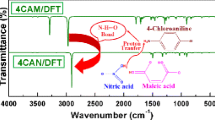Summary
FTIR spectroscopy was used to study the vibrational behaviour of the hydrogen bond system of the H3O2 unit, present with widely varying O-H...O distances in natrochalcite-type compounds, MeCu2(H3O2)(ZO4)2 (Me = Na, K; Z=S, Se). Absorption bands of powder and polarized single-crystal spectra of non-deuterated and partially deuterated natrochalcite phases are assigned to stretching and bending modes of clearly divided OH− and H2O groups. These results are indicative for a not centro-symmetric configuration of the H3O2 unit and confirm the presence of a very strong hydrogen bond with a split hydrogen atom position.
Zusammenfassung
FTIR Spektroskopie wurde zur Untersuchung des Schwingungsverhaltens des Wasserstoff-Brückenbindungssystems der H302 Gruppe herangezogen, die mit stark variierenden O-H... 0 Abständen in Verbindungen des Natrochalcit-Typs, MeCu2(H3O2)(ZO4)2 (Me = Na, K; Z = S, Se) auftritt. Absorptionsbanden von Pulverund polarisierten Einkristallspektren nicht deuterierter und teilweise deuterierter Natrochalcit-Phasen, werden den Streck- und Knickschwingungen klar getrennter OH− und H2O Gruppen zugeordnet. Diese Ergebnisse weisen auf einen nichtzentrosymmetrischen Aufbau der H3O −2 -Gruppe hin und bestätigen das Auftreten einer sehr starken Wasserstoffbrücke mit einer aufgespaltenen Position des Wasserstoffatoms.
Similar content being viewed by others
References
Adams DM, Newton DC (1970) Tables for factor group and point group analysis. Beckman-RIIC Ltd, Croydon, 62 pp
Ardon M, Bino A (1987) A new aspect of hydrolysis of metal ions: the hydrogen-oxide bridging ligand (H3O −2 ). Structure Bonding 65: 1–28
Chevrier G, Giester G, Jarosch D, Zemann J (1990) Neutron diffraction study of the hydrogen-bond system in Cu2K(H3O2)(SO4)2. Acta Cryst C46: 175–177
Chevrier G, Giester G, Zemann J (1993) Neutron refinements of NaCu2(H3O2)(SO4)2 and RbCu2(H3O2)(SeO4)2: variation of the hydrogen bond system in the natrochalcite-type series. Z Kristallogr 206: 7–14
Daniels P, Krosse S, Werding G, Schreyer W (1997) “Pseudosinhalite”, a new hydrous MgAl-borate: synthesis, phase characterization, crystal structure, and PT stability. Contrib Mineral Petrol 128: 261–271
Emsley J (1980) Very strong hydrogen bonding. Chem Soc Rev 9: 91–124
Emsley J, Jones DJ, Lucas J (1981) Detecting and measuring strong hydrogen bonds: recent developments. Rev Inorg Chem 3: 105–140
Franks F (ed) (1973) Water — a comprehensive treatise, vol 2. Plenum Press, New York, 684 pp
Giester G (1989) The crystal structure of Ag+Cu2(OH)(SO4)2·H2O and Me+Cu2(OH)-(SeO4)2 · H2O [Me+ = Ag, TI, NH4], four new representatives of the natrochalcite type, with a note on natural natrochalcite. Z Kristallogr 187: 239–247
Giester G, Zemann J (1987) The crystal structure of the natrochalcite-type compounds Me+Cu2(OH)(zO4)2 · H2O [Me+ = Na, K, Rb; z = S, Se], with special reference to the hydrogen bonds. Z Kristallogr 179: 431–442
Grimm AR, Bacskay GB, Haymet ADJ (1995) Quantum chemical studies of the solvation of the hydroxide ion. Mol Phys 86: 369–384
Hadzi D, Bratos S (1976) Vibrational spectroscopy of the hydrogen bond. In:Schuster P et al. (eds) The hydrogen bond - recent developments in theory and experiments, vol 2. North-Holland Publ, Amsterdam, pp 565–611
Hammer VMF, Libowitzky E, Rossman GR (1998) Single-crystal IR spectroscopy of very strong hydrogen bonds in pectolite, NaCa2[Si3O8(OH)], and serandite, NaMn2[Si3O8(OH)]. Am Mineral 83 (in press)
Kar T, Scheiner S (1995) Proton transfer in H5O +2 and H3O t2 with an external restraining force. Int J Quant Chem: Quant Chem Symp 29: 567–575
Krause W, Belendorff K Bernhardt H-J, McCammon C Effenberger H, Mikenda W (1998) New crystal chemical data for minerals of the tsumcorite group. Ferrilotharmeyerite, tsumcorite, thometzekite, mounanaite, gartrellite and helmutwinklerite. Eur J Mineral 10 (in press)
Libowitzky E, Rossman GR (1996) FTIR spectroscopy of lawsonite between 82 and 325 K. Am Mineral 81: 1080–1091
Luck WAP, Wess T (1991) Semiclassical model calculations of weak, strong, and short O-H... O H-bonds. Can J Chem 69: 1819–1826
Mereiter K (1974) Die Kristallstruktur von Rhomboklas, H5O2 (Fe[SO4]2 2H2O). Tschermaks Min Petr Mitt 21: 216–232
Mereiter K, Zemann J, Hewat AW (1992) Eglestonite, [Hg2]3Cl3O2H: confirmation of the chemical formula by neutron powder diffraction. Am Mineral 77: 839–842
Mikenda W (1986) Stretching frequency versus bond distance correlation of O-D(H)... Y (Y = N, O, S, Se, Cl, Br, I) hydrogen bonds in solid hydrates. J Mol Struct 147: 1–15
Nakamoto K (1978) Infrared and Raman spectra of inorganic and coordination compounds. Wiley, New York, 448 pp
Novak A (1974) Hydrogen bonding in solids. Correlation of spectroscopic and crystallographic data. Structure Bonding 18: 177–216
Nyfeler D, Hoffmann C, Armbruster T, Kunz M, Libowitzky E (1997) Orthorhombic JahnTeller distortion and Si-OH in mozartite, CaMn3+O[SiO3OH]: a single-crystal X-ray, FTIR, and structure modeling study. Am Mineral 82: 841–848
Ratajczak H, Orville-Thomas WJ (1967-68) Hydrogen-bond studies, part 1. The relation between vibrational frequencies and bond length in O-H...O hydrogen-bonded systems. J Mol Struct 1: 449–461
Ryskin YI (1974) The vibration of protons in minerals: hydroxyl, water and ammonium. In:Farmer VC (ed) The infrared spectra of minerals, monogr 4. Miner Soc, London, pp 137–181
Thomas J (1995) Refinement strategy in structural studies of crystalline solid proton conductors. Solid State Ionics 77: 275–279
Tomkinson J (1992) The vibrations of hydrogen bonds. Spectrochim Acta 48A: 329–348
Tuckerman ME, Marx D, Klein ML, Parrinello M (1997) On the quantum nature of the shared proton in hydrogen bonds. Science 275: 817–820
Wiebcke M, Engelhardt G, Felsche J, Kempa PB, Sieger P, Schefer J, Fischer P (1992) Orientational disorder of the hydrogen dihydroxide anion, O2H3, in sodium hydroxosodalite dihydrate, Na8[Al6Si6O24](OH)2. 2H2O: single-crystal X-ray and powder neutron diffraction and MAS NMR and FT IR spectroscopy. J Phys Chem 96: 392–397
Wilson EB, Decius JC, Cross PC (1980) Molecular vibrations. The theory of infrared and Raman vibrational spectra. Dover Publ Inc, New York, 388 pp
Author information
Authors and Affiliations
Additional information
With 4 Figures
Rights and permissions
About this article
Cite this article
Beran, A., Giester, G. & Libowitzky, E. The hydrogen bond system in natrochalcite-type compounds — an FTIR spectroscopic study of the H3O2 unit. Mineralogy and Petrology 61, 223–235 (1997). https://doi.org/10.1007/BF01172486
Received:
Accepted:
Issue Date:
DOI: https://doi.org/10.1007/BF01172486



